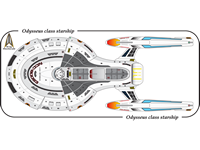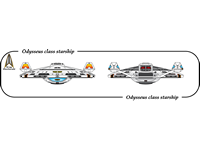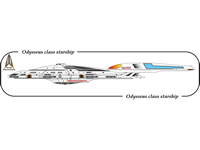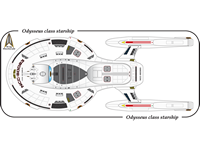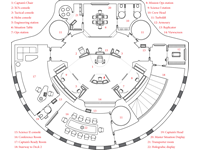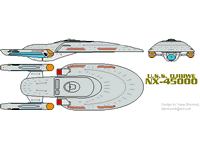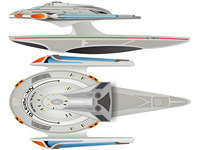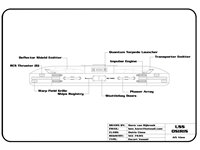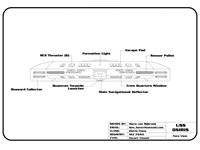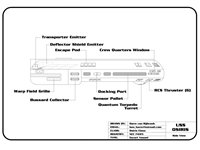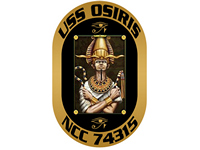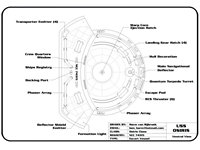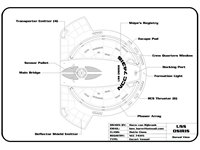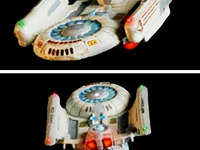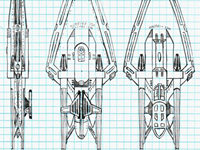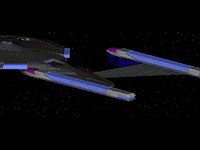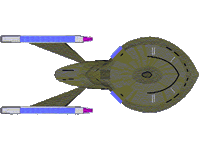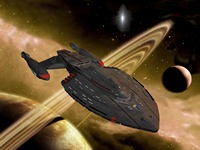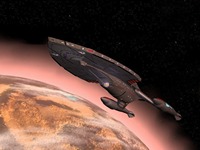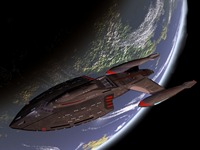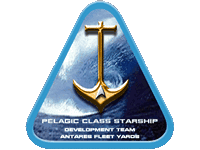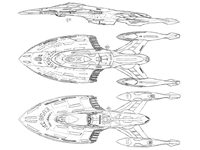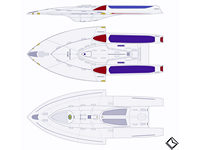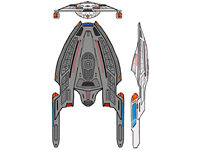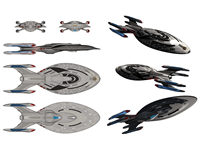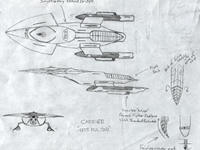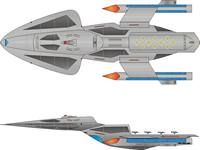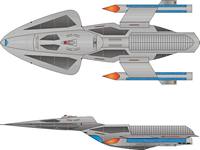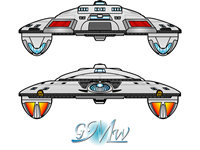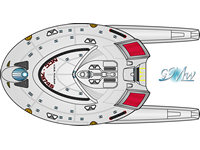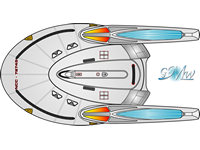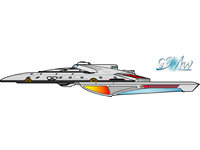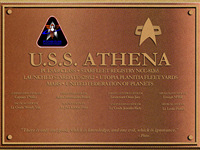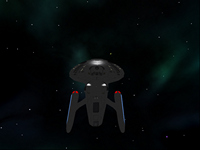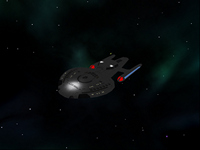Starships O-Q
Starships, Starships A-B, C-E, F-H, I-L, M-N, O-Q, R-S, T-Z, Space Stations
Odysseus Class
Design by Greg MacDonald
Type: Destroyer
First commissioned: 2380
Length: 244m
Width: 138m
Height: 41m
Decks: 9
Complement: 150
Speed: Warp 8 (cruise), Warp 9.8 (max.), Warp 9.95 (max. emergency)
Armament: 11 Type X phaser arrays, 4 pulse fire quantum/photon torpedo tubes + 224 torpedoes
Defense: Regenerative shield system, limited ablative armor paneling
Embarked craft: 1 Aeroshuttle, 1 Type 11 shuttlecraft, 2 Type 9 shuttlecraft, 2 Type 8 shuttlecraft
In 2370, Starfleet had just completed its two most advanced starships, the Sovereign class and the Intrepid class. Both were built with the latest technologies and materials and were faster, stronger and tougher than any starship of similar size had ever been. However, this came with a price, one that, at the time, had seemed reasonable. Due to their complexity, only a handful could be built each year, but with Starfleet's fleet numbers at their highest ever level, this was not seen as a serious concern.
This all changed in 2373 with the opening battles of the Dominion War. Starfleet took devastating losses in the first year and had the Romulans not joined the war effort, it is likely that the war would have been lost. With the Romulans now in the fight, Starfleet had the time to upgrade its existing technology and allow it to switch from a defensive footing to a more offensive nature. The number of ships lost in that first year and the - admittedly greatly reduced - number that continued to be lost posed a grave problem for the fleet. The complex and material intensive starships such as the Sovereign and Intrepid had their build numbers slashed. Although they were among the most powerful ships on the battlefield, they simply took too long to build.
A solution was found in existing designs such as the Akira and Sabre classes. Both were slightly older designs that proved cost effective and much quicker to construct. Another solution was refitting of existing classes, such as the Nova class science ship, which became a capable (if small) destroyer.
In 2375, after the war was won, Starfleet found itself with nearly half its pre-war fleet destroyed or damaged, as did the Romulans and Klingons. Concerned that other powers such as the Breen, Gorn or Tholians might try to take advantage of its weakened state, Starfleet began its largest ever period of shipbuilding, with surviving shipyards producing record numbers of starships. Construction of the Sovereign and Intrepid classes was resumed, but their complex designs proved as slow to build as before the war. This left Starfleet extremely short on ships in the 200-300m range, which had previously been filled by the Miranda class.
The decision was made to design and build a new class of starship, of similar size to the Intrepid, but with a less advanced, but more robust and, most importantly, easier to build design. Although a destroyer, with the war fresh in the designers memories, the design was outfitted with the firepower and defenses of a cruiser. This included stronger phasers, regenerative shields, limited ablative armour plating over key areas and pulse fire torpedo tubes loaded with a supply of quantum torpedoes. The impulse engines were also upgraded, allowing for greater power and acceleration.
Unique to the design were a number of small shield generators situated around the bridge. Independent from the main shield grid, these created a small shield directly around the bridge, providing a crucial backup should the primary shields fail.
This extra firepower came at a cost, warp speeds although considered adequate, fell far short of the Intrepid and Sovereign classes. The warp engines, for ease of design and construction, were based on the previous generation warp drives, used by classes such as the Akira and Galaxy. Some of the advances from the current generation were incorporated though, allowing for a much higher maximum emergency warp than would have otherwise been possible. The increased power requirements of the weapons and defenses necessitated a more powerful, less efficient warp core, reducing the design's range. The ship could only carry fuel for a year's operations, a duration less than half of that of similar sized vessels.
The interior also suffered as a result of the improved combat effectiveness and the ship's low profile. Quarters were smaller, only a single, small holodeck was available and other recreational facilities were limited. A larger than average mess hall with panoramic windows was provided as a concession to crews.
One area of the interior that did not suffer from size issues was the shuttlebay. This was larger than any ship smaller than an Akira and even some larger than it. This and the greater number of shuttles would give the design greatly improved search and rescue facilities. If needed, the shuttlebay could be further expanded into cargo bays one and two, located directly in front of the shuttlebay. A captains yacht, was integrated into the ventral saucer forward of the deflector. The design of it is almost identical to the Aeroshuttle carried by the Intrepid class, although it was equipped with more powerful sensors, allowing it be used as an advance scout.
Construction of the first ship of the class, named Odysseus after the legendary Greek king, was completed in 2379, three and a half years after work began on the design, a remarkably short period. This was only possible due to the use of large numbers of off-the-shelf technologies. The ship spent nearly a year in trials before being commissioned in early 2380. Three more ships were completed within the year, with production planned to be dramatically ramped up and peak at around 48 per annum.
Thanks to the people at the SCN for their feedback and support.
Ojibwe Class
Design by Isaac Abresnick
Type: Destroyer
Length: 435.6m
Beam: 174.2m
Height: 87.1m
Crew complement: 305
No description
Orus Class
Design by Dr. Noonien Soong
Type: Mid-Short ranged science vessel
Commissioned: 2369
Unit run: 8, with 12 under construction
Length: 189m
Crew: 97
Speed: Warp 6.3 (normal cruise); Warp 8.87 (max. cruise); Warp 9.1 (1.2 hours)
Armament: 1 Type XII phaser array, 1 torpedo tube+ 35 quantum torpedoes (upgraded)
Defence: Standard shield emitters with advanced metagenic shield technology
Removable modular mission pod
Auxiliary craft: 3 type 9 shuttlecraft (optional), stored in mission pod
The Orus (originally based on the Cristobal hull configuration) underwent many changes in its construction and development. Often mistaken as a replacement for the still operating Oberth the Orus was designed to be one of a series of ships that each would fulfill the role of the Oberth in a more specified role. The Nova class is one of these vessels, providing scientific research in more "high risk" environments. The Orus was designed to be a vessel that could provide detailed analysis of planets first explored by pathfinding vessels. Thus far the Orus class has proved a favorite among terraformers and other colony planners for its extensive planetary scanning systems.
Osiris Class
Design by Harm van Rijbroek
Type: Escort vessel
Commissioned: 2371-present
Length: 131 m
Beam: 171 m
Height: 26 m
Deck count: 8
Mass: 280,000 tons
Crew complement: 121
Armament: 8 Type-X phaser arrays, total output 32,000 TW, 4 standard fire quantum torpedo tubes + 200 torpedoes, 1 pulse fire quantum torpedo tube + 100 torpedoes
Defence systems: shield system, total capacity 2,500,000 TJ, heavy duranium/tritanium double hull + 12 cm ablative armour, high level structural integrity field
Speed: Warp 8.5 (normal cruise), Warp 9.6 (max. cruise), Warp 9.95 (for eighteen hours, max. rated)
Expected hull life: 75 years
Refit cycle: 1 year (minor), 3 years (standard), 10 years (major)
Unit run: USS Osiris NCC-74315, USS Anubis NCC-74316, USS Nephthys NCC-74318, plus 15 units in production
No description
Owens Class
Design by Jason Abbadon
Type: Fast warp courier
Length: 104m
Width: 65m
Crew: 28 (3 command officers 20 passengers)
Engine Data: 4 warp nacelles, 1 impulse engine system, one warp core
Shields and defensive systems: four Type- VI phaser arrays covering all arcs, advanced regenerative auto modulating shields, transporter inhibitors
Embarked craft: Two emergency evacuation shuttles (not deployed under normal operations)
Number constructed: twelve total with nine in active service and three in readiness but inactive status
The Owens class USS Hermes is one of Starfleet's fast warp couriers for transport of diplomatic personnel and Federation member world representatives and councilors. Designed with high warp speeds and guest comfort in mind, the Hermes is minimally armed and is equipped with several lounges, meeting suites and larger than average cabins. The Owens class of fast couriers has been in service for over a century with each starship having a storied history and unique internal decor, often incorporating real wooden adornments and art from several Federation worlds. While luxury is provided for the VIPs and guests aboard, the starship itself is continually upgraded with the latest in shield and engine systems to provide protection for the passengers. The Owens class has one of the highest sustained warp speeds of the fleet for a ship of its class due to its four nacelles handing off duties as each pair reaches its maximum safe warp endurance time. At maximum performance, the Owens class can sustain Warp 8.8 for forty hours before requiring a two hour cooling down and maintenance period.
Paladin Class
Design by Matthew Taylor
Type: Cruiser
Construction start: 2372
Length: 552m
Width: 184m
Height: 61m
Deck count: 42
Speed: Warp 9.99 (max.), slipstream speed classified
Crew complement: 117 officers, 675 enlisted
The Paladin class is a tactical cruiser, which incorporates the best design elements from the last line of starships. It also boast many of the latest technologies, from the treasures brought home by Voyager, to the advances needed for the Borg attacks and Dominion war, and even breakthroughs from the Starfleet research stations.
She was designed as a point defense ship, capable of showing up within minutes of an emergency call. The design engineers were told to build a ship that can outgun a ship twice her size, and outrun a ship half her size. Whether the Paladin class meets these criteria is yet to be declassified.
Panavia Class
Design by Dan, ASDB Member
Type: Heavy cruiser
Length: 641.4m
Hull length: 467.9m
Total width: 256m
Hull width: 246.9m
Total height: 59.6m
Hull height: 59.0m
Decks: 19
Warp system: Rolls-Royce R1
Max. cruise speed: Warp 8.5
Max. speed: Warp 9.975 (24 hrs)
The project was started in 2367 as a first generation dedicated warship for the Starfleet. The Dominion War of the 2370's, amongst other factors, lead this class to in fact become the frontspiece for the Starfleet Marines; the newly formed, full-time Presidential Section 22.
Technically designated "Heavy (Tactical) Cruisers", the Panavia class was developed at Clyde Bank Naval Yards, Earth. The first batch of three test-bed craft entered service in the last year of the war - and proved thoroughly successful warships.
The general form the starship was an evolution of the Hokule'a class, which Clyde Bank had so successfully developed earlier in the century.
Pelagic Class
Design by Chris Edmonds
Type: Multipurpose explorer/heavy cruiser
Length: 756 meters
Beam: 258 meters
Draft: 115
Decks: 28
Mass: 3.85 million tons
Crew complement: 850 (72 officers, 578 enlisted crew, 150 assorted civilians), maximum emergency capacity of 9,500 persons
Warp speed: Warp 9.99 (for 72 hours)
Max. sublight delta-v: 5200 km/s^2
Armament: 15 Type 12 collimated phaser arrays, 1 Class V Suss-Fire Quantum Torpedo Launcher (later upgraded to Class VI), 4 Class IV Burst-fire Quantum Torpedo Launchers (2 fwd., 2 aft), 600 Quantum Torpedoes, 4 Transphasic Torpedoes
Defense: Regenerative Shields, 6.5 Exajoules, Ablative Armor (Average thickness: 6 cm), Deployable armor over more vulnerable surfaces
Overview
The Pelagic class starship is probably one of the most illustrious starships of the 24th century, ranking up there with the famous Excelsior, Ambassador, Galaxy, and Sovereign classes. Its graceful form resembles more that of the Galaxy class than its direct predecessor, the Sovereign class. Indeed, the Pelagic even resembles the Galaxy class in purpose more than the Sovereign class, as it is a multipurpose explorer vessel rather than a martial warship. Much like the Galaxy class, the regulations for life aboard a Pelagic class starship allow for up to 150 civilians in addition to the 600 crew. First deployed in 2381, the Pelagic quickly earned the title "Goddess of the Stars", coined by her first captain, Captain Toyhiko Kagawa.
In 2388, the Sheliak War erupted. The Pelagic class was quickly drafted into service as a heavy cruiser in the conflict. Despite its stronger shields, more potent phasers, and more complex torpedo systems compared to the contemporary Sovereign class, the Pelagic class lacked the tenacity and endurance record that the Sovereign class was famous for. Pelagic class ships petered themselves out much more quickly than the Sovereign class ships they were serving alongside. Nevertheless, the Pelagic class performed admirably during the war. In fact, the crucial maneuvers during the pivotal battle were made by a Pelagic class ship, the USS Caesar NCC-82185, which intentionally sideswipe-collided with the Sheliak lead ship while it was attempting to collide with the Caesar's sister ship, the Enterprise NCC-1701-F.
Mission
Pursuant to Starfleet Tactical Directive 1281.6 and Starfleet Exploration Directive 1140.1, the following objectives were established for the Pelagic Class Starship Development Project:
- To replace aging Galaxy class starships as the primary instrument of frontier exploration and Federation diplomatic activities.
- To provide a modern multipurpose starship platform to carry out multiple projects in the field of science simultaneously.
- To be the primary instrument of representation of the Federation on the frontiers of known space and provide autonomous capability for the execution of Federation policy in outlying regions.
Propulsion
The Pelagic class starship sadly has no great leap in top speed over the Sovereign, thanks to the Practical Top Warp Speed ceiling reached with the Sovereign and Prometheus classes. However, it does make strides in high warp endurance. Using technology pioneered in the Joan of Arc class, it can maintain its maximum safe speed of Warp 9.99 for easily twice as long as the Sovereign class. It also has a pair of off-axis field controllers of advanced design in its nacelles for augmented turning speed while at warp.
The starship has a fairly subspace-dynamic hull form as well. This is due to very early preliminary design stages where they contemplated installing a Quantum Slipstream Drive into the ship. Unfortunately, the technology required far more corrective research than they anticipated, and the slipstream drive plans were cancelled for the Pelagic class. The subspace-dynamic hull shape has been a part of Advanced Warp Field Geometry research since the days of the Sovereign and Intrepid class's development. The Pelagic's warp field geometry is only slightly more advanced than that of the Sovereign or Prometheus, making its contributions to its warp capability negligible at any speed, save perhaps speeds exceeding its maximum safe.
The Pelagic class's warp core is a Class X Matter/Antimatter reactor, spanning fourteen decks. In order to compact it somewhat, the constrictors are slightly twisted, making the actual length of the core, if untwisted, approximately seventeen decks in height. Much like later model Class IX M/A reactors like on the Sovereign class, this powerplant requires plasma coolant reservoirs directly beside the reaction chamber.
The Pelagic class's impulse drive is perhaps one of the largest ever constructed for a starship. It uses eight fusion reactors each, and utilizes high-powered forcefield thrust vectoring, giving it 180 degrees of vertical vectoring, and approximately 7.4 degrees of horizontal vectoring (This limitation is present on all starships with this form of thrust vectoring, due to the fact that the forcefield generators must be very close to the exhaust vents in order to make a strong enough forcefield). Despite its robust impulse drive, the Pelagic is somewhat slow to accelerate, clocking in at approximately 5200 km/s^2 delta-v. Had its explorer nature not required its impulse powerplants to last as long as possible, its pickup would have been increased by antimatter fuel additives.
Tactical
The Pelagic class starship incorporates several advances in weapons design. It is the first class to come fresh out of drydock with an entire torpedo magazine store designed for Quantum Torpedoes, it carries Fifteen Type 12 phasers , 8 of which in new emplacement arrangements called Double-Broadsides, and it carries a double-layer regenerative multiphasic shielding rated at 6.5 Exajoules maximum strength. In addition, it has a moderately thick layer of second-generation ablative armor, and limited coverage with deployable armor over unprotected areas such as the Bussard ramscoops and warp field grilles.
Class history
Several Pelagic class starships have distinguished themselves during their golden age before the Sheliak War. The USS Theodon NCC-82213, for example, made first contact with a race known as the Anait'sirhc in the rimward frontiers of Federation space. The USS Poseidon and he sister ship, the USS Neptune expanded the coreward frontiers over 1500 light years. Probably the most famous Pelagic class Starship of all is even more famous for her name: The USS Enterprise NCC-1701-F, under the command of Captain James Winter. In the one year she was around before the Sheliak War, the Enterprise-F averted a diplomatic crisis between the Anticans and the Selay, mapped out the depths of occupied Cardassian territory (an opportunity they never had before the Dominion war), and took part in some important Romulan/Starfleet diplomatic exchanges. During the Sheliak War, the Enterprise made a legend of herself, becoming one of the few starships the Sheliak actually feared. There are a few instances of Sheliak turning tail and retreating when the Enterprise-F arrived on the scene.
The Pelagic class is no longer the ship of the line in Starfleet, now that the slip-capable Phoenix class starship has arrived. The Pelagic class is utterly outperformed in regards to combat prowess, superluminal speeds, and overall efficiency compared to the Phoenix. However, due to the Phoenix's more martial purpose, the Pelagic class still makes a good diplomatic and explorer vessel. The Pelagic class still is constructed at Utopia Planitia Fleet Yards and Antares Fleet Yards in more limited numbers and is planned to be around still well into the 25th Century.
This starship is featured in the fanfic Star Trek: Renaissance.
Pendragon Class
Design by Voron
Type: Exploratory cruiser
First commissioned: 2384
Length: 440m
Width: 160m
Height: m
Decks: 15
Complement: 20 officers + 180 crew, evacuation limit: 350
Speed: Warp 9.7 (cruise), Warp 9.9 (max.), Warp 9.98 (max. emergency)
Armament: Phaser: 5 Type XII 6 Type IX Torpedo: 3 forward firing burst fire launcher, 2 Aft Burst fire launcher Torpedo complement 350 quantum torpedoes
Defense: Standard shield system, Ablative armour
Embarked craft: 2 type 18 shuttle pods, 6 type 20 shuttles and 2 Delta Flyer class runabouts
Designed to replace the Excelsior class star ships, the Pendragon class Cruiser represents the cutting edge and flagship of the whole Starfleet Cruiser range of Starships. The Pendragon class shares its history with the Bradbury and Intrepid class vessels which shows in the graceful lines of the Pendragon class vessels. The Pendragon class fits the multi-role purpose with great ease and contains excellent scientific equipment and ideal tactical systems for a vessel with a total crew of two hundred and eighty five and 15 decks decks.
The design borrows heavily from the Bradbury class and can be classed as a direct descendent of this class. Its combines the integrated engines in to the primary hull due to Improvements in Warp Coil efficiency allow for a stronger structural support of the nacelles. But instead of the twin hulls of the Bradbury a single hull was chosen to eliminate the deflector balance problem. For scientific duties the Pendragon class uses the brand new 5th generation sensor suite and the Holographic Science and Command Centre which has seen a lot of success in its deployment among the fleet since its birth in the Titan and Ajax class vessels. The new 5th generation sensor systems include further ability to scan on multiple resolutions with over four thousand channels being processed at once during scans and a cycle of less then a tenth of a second per sensor scan. The data from these sensors are fed to one of the five science labs or stellar cartography labs or if the Pendragon is being used as a command ship for taskforces to the fleet operations room located on deck three. This facility use holographic displays to create a 3D map of the surrounding space and display it to the command crew usually headed by an admiral; this is to allow for better co-ordination of fleets in exploration of unknown space or in massed fleet engagements. Additionally the new generation sensor system has the ability to monitor multiple larger craft and more importantly smaller vessels such as the recent trend of technology the new generation of fighters.
The main offensive weapons system carried by these ships is the quantum torpedo, which can be, launched from any of the 5 torpedo launchers. The maximum number of torpedoes that can be carried is 350. This is only ever carried on a tactical mission. Mainly 250 quantum torpedoes are carried with twenty to thirty casings for probes. These are split between the five torpedo armours. The 5 Type XII Phaser arrays are proved for both offence and defence. These new Phasers have a 10% greeter power output than the type tens used during the Dominion war. Type XII collimated arrays, which are capable of roughly 5,000 terawatts, and three beams. There are 6 Type IX Phasers placed over the hull. These Phaser are more defence orientated the main arrays though they can be used in an offence role there main objective is defence from small ships such as fighters bombers and small to medium sized ships. The defensive systems on the Pendragon class consist of two separate parts: shields and armour. The shields are standard multiphase regenerative shields, with a primary and secondary layer. The amount of energy they can deflect is roughly 9 million terajoules before being completely depleted, and has a replenishment rate of 5,000 terajoules per second. The armour is based on the same type 2 armour used during the Dominion war with improvements and modifications from the USS Voyager AAG system allowing it to last longer (on average 4 times longer) before being penetrated.
So far three more ships are under construction these are the Lancelot, Gawain and the Morgan La Fey. There is a planned production run of fifty ships by 2489 and the possibility of fifty more if there is a need.
Perimeter Class
Design by T. Junk
No specs available
No description
Pioneer Class (2)
Design by Rian
Type: Cruiser/explorer
First commissioned: 2399
Length: 680m
Decks: 22
No description
Pulsar Class (1)
Design by Chris Daly
Type: Starfighter carrier
Length: 324m
Width: 126m
Height: 54m
Mass: 740,320t
Decks: 13
Crew complement: 42 officers (36 Ship Operations, 6 Fighter Operations), 326 enlisted (240 Ship Operations, 86 Fighter Operations), 72 flight officers (Pilots/Navigators)
Velocity (Warp): Warp 7.6 (std. cruise), Warp 9.7 (max. cruise), Warp 9.98 (max. sustainable), Warp 9.998 (operational limit, 96h), Warp 9.99976 (theor. limit, 480s, warp coil damage)
Structural integrity field not rated above Warp 9.999
Armament: 8 Type-X phaser arrays (2 on saucer, 1 dorsal, 1 ventral; 6 on main hull, 4 dorsal, 2 ventral)
48 quantum torpedoes (3 launchers, 2 fore, 1 aft, 16 torpedoes each)
Possibility of 10 transphasic torpedoes during operations against Borg (restricted technology under Temporal Prime Directive)
Standard ablative armour paneling
Internal self-sealing armour - hangar fairing
Trinary cyclic matrix shielding (3 overlapping, independent frequency, shield matrices)
Load: 36 Valkyrie / 24 Peregrine fighters (3 and 2 squadrons respectively) in hangar area, arranged in 6 groups of 4: 2 groups on flight deck, 2 groups in central hangar, 2 groups in sub hangar, 4 Type-9 light shuttles, 4 Type 7a medium shuttles in shuttlebay
USS Pulsar, the prototype ship, was commissioned in 2365. Ships of the class:
- USS Pulsar, NX-81712
- USS Hornet, NCC-81816
- USS Wasp, NCC-81837
- USS Nimitz, NCC-81854
- USS Ark Royal, NCC-81865
The Pulsar-class starfighter carrier is one of only a handful of fighter-carrier starship classes ever used by Starfleet. Fighters have always been considered to be too weak, too few and too resource-dependant for serious strategic deployment throughout the Federation, as shown by the numerous larger ship sizes in service, however, fighters have been used as escorts and light attack craft for some time. Experience during the Cardassian War showed that lighter vessels could, in numbers, take on far larger starships, with a minimum of lives risked. Later confrontations with the Borg lead to miniaturisation and power increases with all forms of weapons, shields and sensor systems.
Peregrine
Fighters were used as border patrols for some ten years before the first encounter with the Borg, and this terrible defeat lead to them being upgraded to a more useful standard, to defend colony worlds. It also initiated the Valkyrie Program, to create a modernised, smaller, but more powerful fighter. The Valkyries acquitted themselves well during a skirmish in the Typhon sector, however, their carrier ship, which was designed hurriedly using components from existing starships, seemed to be a liability, and needed constant defence from its fighters. The facts that it only carried one squadron (12 fighters), and was capable of speeds no higher than Warp 9, were also a major problem.
Using data and systems gathered from fields of research into the Sovereign, Defiant and Intrepid
Classes, and some explored specifically for this project, a Starfleet design team was commissioned to create a prototype. The USS Pulsar (NX-81712) rolled off the production lines towards the end of 2365, and was immediately trialled. After a few short weeks, Starfleet ordered eight more ships to be built, and the prototype was placed straight on the front lines, operating with Task Force 12 out of Starbase 218. The most elite fighter squadron in Starfleet, Red Squad, immediately boarded the ship, with two other squadrons (Solarfire and Raptor) and their compliment of Valkyrie Fighters.
The Pulsar and its crew participated in many raids, including one deep-penetration mission to destroy a Dominion supply post at Gamma Eridicea VI. The Pulsar, with an escort in the form of the Intrepid-class USS Tomahawk (NCC-79376), flew in at high-warp velocity, and upon reaching the supply post released the three squadrons. The Dominion Post was easily destroyed, with the Pulsar destroying parts of the defence grid in support of the fighters. Within minutes the squadrons had re-docked, however three Dominion Destroyers and a Cardassian Galor-class warship entered the area. The Pulsar eliminated two of the destroyers and helped the Tomahawk attack the Galor, damaging it beyond repair. Both safely warped back to Federation lines, with the loss of only 28 crew between them. Since then, the Pulsar and its sister ships have helped to patrol and provide assault support in case of Borg Incursion or sparse hostile incidents.
Pulsar Class (2)
Design by Greg MacDonald
Type: Patrol/combat support/convoy escort
First commissioned: 2380
Length: 145.8m
Width: 74.7m
Height: 25.4m
Decks: 4.5
Displacement: 500000t
Complement: 6 officers + 30 crew, evacuation limit: 180
Speed: Warp 5 (cruise), Warp 9.4 (max.), Warp 9.7 (max. emergency)
Sublight speed: 0.35c (max.)
Armament: 6 Type VIII phaser arrays, 1 Type I burst fire torpedo turret + 25 photon torpedoes, 2 pulse fire torpedo tubes + 20 photon torpedoes each
Defense: auto-modulating shield system, 4cm ablative armour
Embarked craft: 1 Type 9 shuttlecraft, 2 Type 8 shuttlecraft, 1 Workbee
The Pulsar class, commissioned in 2380, is Starfleet's bare bones small workhorse. Often mistaken for a Saber replacement, the Pulsar in fact holds a somewhat unique mission profile, at least in comparison to most modern Starfleet vessels. She does bear kinship to the Norway, however, along with the Asgard family, from which many of her components and design features were derived from.
Most of the interior space is devoted to cargo bays, propulsion systems, and weapons. The patrol cruiser carries little in the way of scientific capability or modularity. The heavy-duty warp core is vertically mounted in a heavily armored column running through the middle of the ship, and is capable of being ejected via a ventral hatch, as are the anti-matter tanks. The core provides power for a pair of Assiduous AN-3 warp nacelles, known for their long lifespan and relative simplicity; the nacelles are much easier to repair in the field than their counterparts, which is critical on sparsely populated border patrol routes where the nearest spacedocks are sometimes light years away. The nacelles provided adequate cruising speed, and a maximum warp speed of Warp 9.7 for high speed jaunt along the border. Impulse speed is excellent, surpassing both the Defiant and Intrepid classes. It is supplemented by a plethora of small maneuvering thruster packages, which lend the vessel astonishing agility.
The Pulsar's armament is relatively potent for a vessel its size, comprising half a dozen decent Type-VIII phaser arrays couple with a trio of torpedo launchers. The main weapon of the vessel is the forward photon torpedo turret, capable of spitting out devastating volleys quickly and accurately. The phaser strips provide good all around coverage, with one large dorsal array and a pair of long ventral arrays perfect for strafing, along with a pair of dorsal arrays protecting the aft and another mounted below the shuttlebay. Regenerative shielding and several cm. of ablative armor serve as defense, along with the vessel's remarkable agility.
A single Type-9 shuttlecraft serves as a high-speed courier, while two Type-8s serve as the workhorse auxiliary craft of the vessel. A single Workbee is available to effect repairs.
The Pulsar is relatively easy and cost effective to assemble, and is quickly replacing older or more scientifically capable vessels along the border. It provides an excellent deterrent for pirates and small warships, and is highly effective in packs with Sabers, Defiants, or other Pulsars. While some say with the resolution of minor Romulan hostilities and the devastating Breen War there is no need for the vessel, others choose to disagree; production of a large number of small Pulsars leaves frees up multi role ships for other tasks and provides an excellent first line of defense. Only time will tell whether the Pulsar continues to shine brightly.
Design by Greg, description by USS Paladin
Pulsar Class (3)
Design by Matthew Dunham
Type: Long-range science/emergency hospital vessel
First commissioned: 2385
Length: 284m
Width: 122m
Height: 40m
Decks: 11
Cargo Capacity: 14,000 metric tons
Hull: Duranium-tritanium composite
Complement: 8 officers + 176 crew, evacuation limit: 600
Speed: Warp 8 (cruise), Warp 9.9 (max.), Warp 9.975 (max. emergency)
Sublight speed: 0.25c (max.)
Armament: 10 Type-X phaser arrays, 3 burst-fire quantum torpedo launchers (120 torpedos)
Defense: Auto-modulating, metaphasic and regenerative Shield Grid
Embarked craft: 4 Type-9 personnel shuttles, 2 Type-11 atmospheric shuttles
Personnel: 184
Command: 8
Flight control: 12
Operations: 9
Engineering: 18
Security/tactical: 24
Science: 46
Medical: 54
Counseling: 3
Civilian: determined by crew wishing to have families join them, subject to CO approval.
Development project started: September 2nd, 2380
Production started: March 12th, 2385
Production ended: Still in production (2386)
Current class status: In service
Current starships of class
- USS Pulsar NX-81260
- USS Aphrodite NCC-81261
- USS Apollo NCC-81262
- USS Ares NCC-81263
- USS Artemis NCC-81264
- USS Athena NCC-81265
- USS Demeter NCC-81266
- USS Hecate NCC-81267
- USS Hephaestus NCC-82168
- USS Hera NCC-82169
- USS Hermes NCC-82170
- USS Hestia NCC-82171
- USS Nike NCC-82172
- USS Poseidon NCC-82173
- USS Zeus NCC-82174
Mission objectives
- Provide autonomous platform for planetary survey outside the Federation.
- Provide a platform for extended scientific survey and planetary diplomacy.
- Replace the Nova class in deep-space exploration duties.
Departments
Main Bridge: The bridge of the Pulsar class is a slightly scaled down and reworked version of the Intrepid class bridge. At the rear of the bridge is the master systems display. To the port of the MSD is the main science station, to the starboard is tactical. The rail running behind the captain and first officer's chairs has been removed in order to shrink the bridge size. There is a turbolift to the side of the main science station and there are doors leading to the conference lounge next to tactical and the main science console. The secondary science station is to the starboard of the captain's chair, with the engineering console on the port side of the first officer's chair. The ops station is directly in front of the captain's chair with the helm next to it, in front of the first officer's chair. The captain's ready room is off to the side of the secondary science station, and the bridge lounge is off to the side of the engineering station.
Main Engineering: Located on deck eight, Main Engineering is the "heart" of the ship, whilst the bridge is the "brain". From engineering personnel are capable of doing everything that they could do on the bridge in addition to managing repairs, power distribution, and general maintenance. There is only one level of engineering as advancements have been made in warp core design and efficiency rendering the need of a second level obsolete. However the warp core still runs the entire height of the stardrive section and is completely accessible through the ship's Jefferies tubes.
Medical systems: Sickbay is located on deck four, and is equipped with two intensive care units, a biohazard unit, a radiation treatment ward, two surgical wards, two isolation wards, one dental ward, a pediatric ward, and the ships morgue. The Chief Medical Officer's office is attached to main sickbay which contains six biobeds, with twelve more in the main treatment ward, and four in the auxiliary sickbay on deck eight. There are holographic emitters installed throughout the entire ship to allow the Long-term Medical Hologram Mk. II access to patients who cannot be moved in their current condition or accessed by normal medical personnel. The Counselor's office is also located on deck four adjacent to the main treatment ward.
Emergency medical operations: In accordance with Starfleet General Policy and Starfleet Emergency Medical Operations, all crew on board a Pulsar class ship are able to serve as Emergency Medical Technicians, triage specialists, medics, and other emergency medical functions. Both of the cargo bays, the shuttlebay and the general purpose science labs can be converted into emergency treatment wards.
Long-term medical hologram: All starships constructed after 2382 come equipped with a Long-term Medical Hologram that can be activated continuously for as long as three years without any loss of program stability. With holo-emitters installed throughout the ship, the LMH can go anywhere to treat any patient that the normal medical staff would not be able to treat.
Science labs: There are twenty-two science labs on the Pulsar class ship, four of which are non-specific that can be modified for various scientific fields. There are four labs on deck four, eight on deck five, four on deck six, and six on deck seven. In all there are two astronomical analysis labs, two astrophysics labs, two botany labs, one cybernetics lab, four general purpose reconfigurable labs, one genetics lab, one high-energy physics lab, four medical research labs, four planetary survey labs, and one exobiology lab.
Security Department: This multi-room department is located on deck eight in a restricted area. The security office is located here as well as the ships brig, phaser range and armory. The ship's torpedo/probe magazine is also located on deck eight opposite the security office.
Security office: The security office provides access to the rest of the department through a set of doors just as you exit the turbolift. There is always a security officer on duty here but the chief of security is rarely here because they are usually taking care of other aspects of the ships security.
Brig: The only way to get to the brig is through the security office. The Pulsar class has five single occupancy cells, which contain beds, a retractable table, sink, and sanitary facilities. The cells are blocked by a level ten forcefield that is controlled from a small station inside the brig by a security officer who is always present if the brig is occupied.
Internal forcefields: The ship's internal forcefields can be controlled from the security office or from the bridge's tactical station. They can be used to isolate intruders until a security team arrives as well as restrict access to certain areas of the ship.
Internal sensors: Used to monitor the internal security of the ship the internal sensors can be operated from the security office or the ops station on the bridge. Mainly used to locate intruders, the internal sensors can also be used to locate crewmen with or without their commbadges.
Armory: The Pulsar class' armory is under constant guard by two security officers armed with type three phaser rifles. No one is allowed access unless they have clearance from the Chief of Security or the First Officer. The armory contains a few workstations for repair of the weapons stored aboard ship as well as a replicator specifically designed to replicate the parts needed to repair the various weapons present.
The inventory of weapons aboard a Pulsar class ship include: 150, Type-2 hand phasers, 50 Type-3 phaser rifles, 20 Type-3 pulse rifles, 10 Type-3 assault rifles, 4 isomagnetic disintegrators
Torpedo/probe magazine: The ships unarmed quantum torpedoes as well as the warheads for the torpedoes are stored here along with a various assortment of probes. There are also enough spare components to manufacture/repair fifty quantum torpedoes.
Ship weapons
Phasers: The Pulsar class ship while being classified as a science vessel is still expected to be able to hold its own out where reinforcements are usually a day away maximum warp. As such it has been outfitted with ten Type-X phaser arrays, two on top of the saucer section, one on the bottom of the saucer section, two on the aft of the saucer on either side and above the shuttle bay, there is one array on each side of the engineering hull, as well as one on the bottom of the engineering section, the last two arrays are on the aft underside of each warp nacelle pylon.
Torpedo launchers: The ship has three rapid-fire quantum torpedo launchers each capable of launching four torpedoes one after another when fully loaded. Two launchers face fore in between the main navigational deflector and the primary hull, and one launcher facing aft below the main shuttlebay. It takes approximately three seconds to fully reload a launcher and another second until the torpedoes are properly configured and able to launch. The Pulsar class ships carry one-hundred and twenty quantum torpedo casings and warheads.
Shields: The shields installed on the Pulsar class are a result of Starfleet's ever recurring encounters with the Borg and the mandate of this class of ships mission. There are a total of twelve shield emitters installed with six functioning as the primary generators and the other six functioning as backups in case shield power drops below safety levels. The shield grid is auto-modulating, metaphasic, and regenerative meaning that the shields will automatically adjust themselves to best match the incoming weapons frequency, as well as resist most forms of solar radiation and allow the ship to remain is closer proximity to a star for longer periods that previously thought possible. The shields also "regenerate" meaning that when shield levels drop below their safe limit the backup generators will power on and take the brunt of any attack to that section while the primary generator of the section recharges.
Computer
Computer cores: The main computer core sits, right below the bridge conference room, on deck two and spans a total of four decks, down to deck five. The auxiliary core is located behind main engineering and spans decks seven through nine. The computer cores on Pulsar class vessels also contain a prototype independent AI.
AI: The ship's AI is in charge of regulating power, as well as automatically performing reaction tasks that humanoids simply can't do fast enough, such as raising the shields before an enemy attack hits home and auto-ejecting the warp core incase of possible breach are possible tasks. The AI also is responsible for the organization and storage of data collected from the ships sensors.
Propulsion
Warp drive: The warp core onboard a Pulsar class ship is a smaller more efficient version of the core present in Intrepid class vessels. The normal cruising speed of a Pulsar class ship is Warp 8, the maximum standard warp is Warp 9.9, and the emergency warp speed attainable for only twelve hours is Warp 9.995.
Impulse driveOutfitted with two matter/antimatter reaction powered impulse drives, one to each side of the shuttlebay, the Pulsar class is able to attain 0.25c at full impulse, though this can be overridden up to 0.45c at the cost of severe space-time distortions.
Reaction control system: Type 4 magneto-hydrodynamic gas-fusion thrusters allow the ship to make erratic maneuvers normally not possible under impulse power alone.
Navigational deflector: The navigational deflector dish is located in the engineering hull, just forward of main engineering and right below the forward torpedo launchers. Composed of molybdenum/duranium mesh panels over a tritanium framework (beneath the engineering hull), the dish's shield and sensor power comes from two graviton polarity generators located on deck nine.
Other systems
Tractor beams: The multiphase subspace graviton beam, or tractor beam, is used to manipulate and object ranging from submicron to macroscopic in size. There are three tractor emitters on a Pulsar class ship, one on the ventral section of the engineering hull, one on the ventral surface towards the fore end of the saucer section, and the last emitter is located on the dorsal side of the engineering hull, between the warp nacelle pylons.
Transporter systems: There are 7 transporters on board Pulsar class ships, ranging from personnel transporters to emergency transporters. There are three personnel transporters; two are on deck six, and the other one is on deck two. The two cargo transporters present are in the cargo bays on deck seven. There is one emergency transporter on deck eight outside of main engineering and the other is on deck three.
Pulsar class vessels are capable of atmospheric entry and egress with equipment worked into the physical design of the starship. Each Pulsar class vessel is equipped with anti-gravity generators as well as impulse and RCS lifters strategically placed at the mass and stress points on the bottom portion of the engineering section. During Blue Alert, the Pulsar class lowers the projection sphere of the deflector shields and assumes an angle of attack perpendicular to the angular rotation of the planetary body if it has an atmosphere. This allows the vessel's shape to work as a lifting body with air traveling under the broad and flat saucer and under the wing-like nacelle struts. Once in the atmosphere, navigation is controlled with RCS thrusters and use of the aft impulse engines. It is standard procedure to lower the landing gear at approximately 2500m above the Landing Zone (LZ) surface, regardless of LZ altitude. This minimizes the drag on the vessel. Once prepared for landing, aft impulse engines are shut down and four vents on the ventral hull are opened. These vents cover the ventral impulse thrust plates. Impulse engines in miniature, the thrust plates serve only to provide lift to the Pulsar class as the anti-gravity generators effectively reduce its weight. The RCS thrusters provide final maneuvering power. Once on the ground, crew or equipment can be transported to the surface from the vessel, or use the ship's turbolift system that connects to channels inside the landing struts themselves, and open out near the 'feet'. Take-off is done in reverse.
Sensors
Long range and navigation sensors are located behind the main deflector dish, to avoid sensor "ghosts" and other detrimental effects consistent with main deflector dish field output. Lateral sensor pallets are located around the rim of the entire Starship, providing full coverage in all standard scientific fields, but with emphasis in the following areas:
- Astronomical phenomena
- Planetary analysis
- Remote life-form analysis
- EM scanning
- Passive neutrino scanning
- Parametric subspace field stress (a scan to search for cloaked ships)
- Thermal variances
- Quasi-stellar material
Each sensor pallet (thirteen in all) can be interchanged and re-calibrated with any other pallet on the ship. The Pulsar class starship is equipped with two high-power science sensor pallets in the forward saucer section, ventral side. The pallets are not plated for ease of upgrade and repair, as well as enhancing sensor acuity. The astrometrics laboratory is located on deck seven. All information received from the astrometric sensors is directed to the bridge main science station where it can be reviewed by the science officer on duty or put on the main viewscreen to display to the bridge crew. The astrometrics lab is always crewed by at least one individual and can have up to five personnel present at a time.
Probes
There are nine different classes of probes, which vary in sensor types, power, and performance ratings. The spacecraft frame of a probe consists of molded duranium-tritanium and pressure-bonded lufium boronate, with sensor windows of triple layered transparent aluminum. With a warhead attached, a probe becomes a photon torpedo. The standard equipment of all nine types of probes are instruments to detect and analyze all normal EM and subspace bands, organic and inorganic chemical compounds, atmospheric constituents, and mechanical force properties. All nine types are capable of surviving a powered atmospheric entry, but only three are special designed for aerial maneuvering and soft landing. These ones can also be used for spatial burying. Many probes can be real-time controlled and piloted from a starship to investigate an environment dangerous hostile or otherwise inaccessible for an away-team. The nine standard classes of probe that Pulsar class ships carry are:
- Class I Sensor Probe: 4
- Class II Sensor Probe: 6
- Class III Planetary Probe: 10
- Class IV Stellar Encounter Probe: 4
- Class V Medium-range Reconnaissance Probe: 4
- Class VI Communications Relay/Emergency Beacon: 4
- Class VII Remote Culture Study Probe: 8
- Class VIII Medium-range Multimission Warp Probe: 4
- Class IX Long-range Multimission Warp Probe: 4
Shuttlebay
The main shuttlebay is located in the aft section of deck four on the saucer section. This is the main location for egress and entrance to the ship as well as the center for all of the Pulsar class's shuttle traffic. Shuttlecraft list:
- Type-11 Atmospheric Shuttles: 2
- Type-9 Personnel Shuttles: 4
Escape pods: There are enough escape pods on board to evacuate up to one hundred eighty personnel, which roughly translates into thirty escape pods, though there are forty-six escape pods fro a total evacuation capacity of two-hundred and seventy-six personnel.
Mission types
Seeking out new worlds and new civilizations is central to all that Starfleet stands for. The Pulsar class Long-range Science Vessel facilitates this, outfitted for long-duration missions over planets and systems, cataloging and monitoring anything and everything of interest inside a designated area. Missions for a Pulsar Class starship may fall into one of the following categories, in order of her strongest capable mission parameter to her weakest mission parameter.
Ongoing scientific investigation: A Pulsar class starship is equipped with scientific laboratories and a wide variety of sensor probes and sensor arrays, as well as the state-of-the-art dorsal subspace sensor assembly; giving her the ability to perform a wide variety of ongoing scientific investigations.
Contact with alien life-forms: Pursuant to Starfleet Policy regarding the discovery of new life, facilities aboard the Pulsar class include a variety of exobiology and xenobiological suites, and a small cultural anthropology staff, allowing for limited deep-space life form study and interaction.
Federation policy and diplomacy: A Pulsar class starship's secondary role is the performance of diplomatic operations on behalf of Starfleet and the United Federation of Planets. These missions may include transport of delegates, hosting of negotiations or conferences aboard in the vessel's conference room, courier for important people and/or items, and first contact scenarios.
Tactical/defensive operations: Though not designed primarily for battle, the Pulsar Class, like all Starfleet vessels, is designed to be resilient and ably armed.
Emergency/search and rescue: Typical missions include answering standard Federation emergency beacons, extraction of Federation or Non-Federation citizens in distress, retrieval of Federation or non-Federation spacecraft in distress. Planetary evacuation is not feasible but the Pulsar class has an evacuation capacity of approximately three-hundred twenty humanoid life-forms.
Deck layout
- Saucer section deck 1: Main Bridge, Captain's Ready Room, Conference Room, and Bridge Lounge
- Deck 2: Officer's Quarters, V.I.P. Quarters, Transporter Room 1, and the Mess Hall
- Deck 3: Crew Quarters, Holodecks 1 & 2, Cargo Bays 1 & 2, and Gym 1
- Deck 4: Crew Quarters, Main Shuttle Bay, Main Sickbay, Science Labs 1-4
- Deck 5: Crew Quarters, Aft Torpedo Launcher, Science Labs 5-12
- Deck 6: Crew Quarters, Transporter Rooms 2 & 3, Science Labs 13-16
- Deck 7: Crew Quarters, Science Labs 17-22, Astrometrics
- Engineering section deck 5: Crew Quarters, Cargo Bay 3
- Deck 6: Crew Quarters, Schools
- Deck 7: Crew Quarters, Forward Torpedo Launchers
- Deck 8: Crew Quarters, Security Department, Auxiliary Sickbay
- Deck 9: Crew Quarters, Main Engineering
- Deck 10: Matter/Antimatter Storage
- Deck 11: Landing Struts, Matter/Antimatter Storage
Thanks to Major A Payne and Chiletrek of FileFront.com forums for creating the mesh and design ideas.

